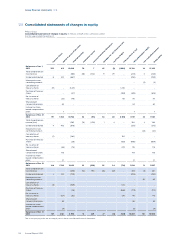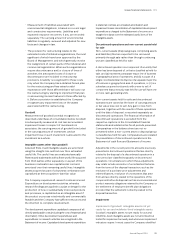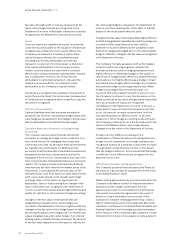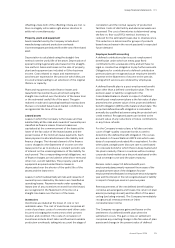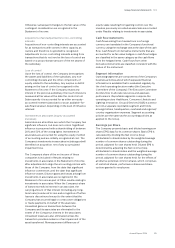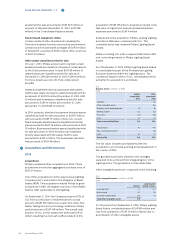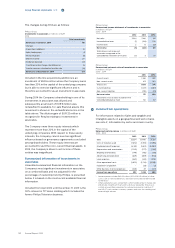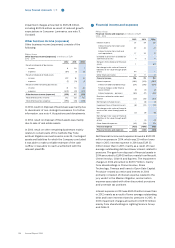Philips 2014 Annual Report Download - page 124
Download and view the complete annual report
Please find page 124 of the 2014 Philips annual report below. You can navigate through the pages in the report by either clicking on the pages listed below, or by using the keyword search tool below to find specific information within the annual report.Group nancial statements 12.9
124 Annual Report 2014
benet obligation. Past service costs following from the
introduction of a change to the benet payable under
a plan or a signicant reduction of the number of
employees covered by a plan, are recognized in full in
the Statement of income.
Short-term employee benet obligations are measured
on an undiscounted basis and are expensed as the
related service is provided. The Company recognizes a
liability and an expense for bonuses and prot-sharing,
based on a formula that takes into consideration the
prot attributable to the Company’s shareholders after
certain adjustments. The Company recognizes a
provision where contractually obliged or where there is
a past practice that has created a constructive
obligation and the obligation can be measured reliably.
The Company’s net obligation in respect of long-term
employee benets is the amount of future benet that
employees have earned in return for their service in the
current and prior periods, such as jubilee entitlements.
That benet is discounted to determine its present
value. Remeasurements are recognized in the income
statement in the period in which they arise.
Share-based payment
The grant-date fair value of equity-settled share-
based payment awards granted to employees is
recognized as personnel expense, with a
corresponding increase in equity, over the vesting
period of the award. The Company uses the Black-
Scholes option-pricing model and Monte Carlo
sampling to determine the fair value of the awards,
depending on the type of instruments granted and
certain vesting conditions.
Financial income and expenses
Financial income comprises interest income on funds
invested (including available-for-sale nancial assets),
dividend income, net gains on the disposal of available-
for-sale nancial assets, net fair value gains on nancial
assets at fair value through prot or loss, net gains on
the remeasurement to fair value of any preexisting
available-for-sale interest in an acquiree, and net gains
on hedging instruments that are recognized in the
Statement of income.
Interest income is recognized on accrual basis in the
Statement of income, using the effective interest method.
Dividend income is recognized in the Statement of income
on the date that the Company’s right to receive payment is
established, which in the case of quoted securities is
normally the ex-dividend date.
Financial expenses comprise interest expenses on
borrowings and on the net dened benet liability,
unwinding of the discount on provisions and contingent
consideration, losses on disposal of available-for-sale
nancial assets, net fair value losses on nancial assets
at fair value through prot or loss, impairment losses
recognized on nancial assets (other than trade
receivables), net interest expenses related to dened
benet plans and net losses on hedging instruments
that are recognized in the Statement of income.
Financial guarantees
The Company recognizes a liability at the fair value of
the obligation at the inception of a nancial guarantee
contract. The guarantee is subsequently measured at
the higher of the best estimate of the obligation or the
amount initially recognized.
Basis of consolidation
The Consolidated nancial statements include the
accounts of Koninklijke Philips N.V. and all subsidiaries
that the Company controls, i.e. when it is exposed, or
has rights, to variable returns from its involvement with
the investee and has the ability to aect those returns
through its power over the investee. The existence and
eect of potential voting rights are considered when
assessing whether the Company controls another
entity. Subsidiaries are fully consolidated from the date
that control commences until the date that control
ceases. All intercompany balances and transactions
have been eliminated in the Consolidated nancial
statements. Unrealized losses are eliminated in the
same way as unrealized gains, but only to the extent
that there is no evidence of impairment.
Business combinations
Business combinations are accounted for using the
acquisition method. Under the acquisition method, the
identiable assets acquired, liabilities assumed and any
non-controlling interest in the acquiree are recognized
at the acquisition date, which is the date on which
control is transferred to the Company.
The Company measures goodwill at the acquisition
date as:
• the fair value of the consideration transferred; plus
• the recognized amount of any non-controlling
interest in the acquiree; plus
•if the business combination is achieved in stages, the
fair value of the existing equity interest in the
acquiree; less
• the net recognized amount (generally fair value) of
the identiable assets acquired and liabilities
assumed.
Costs related to the acquisition, other than those
associated with the issue of debt or equity securities,
that the Company incurs are expensed as incurred.
Any contingent consideration payable is recognized at
fair value at the acquisition date and initially is
presented as Long-term provisions. When the timing
and amount of the consideration become more certain,
it is reclassied to Accrued liabilities. If the contingent
consideration is classied as equity, it is not remeasured
and settlement is accounted for within equity.


